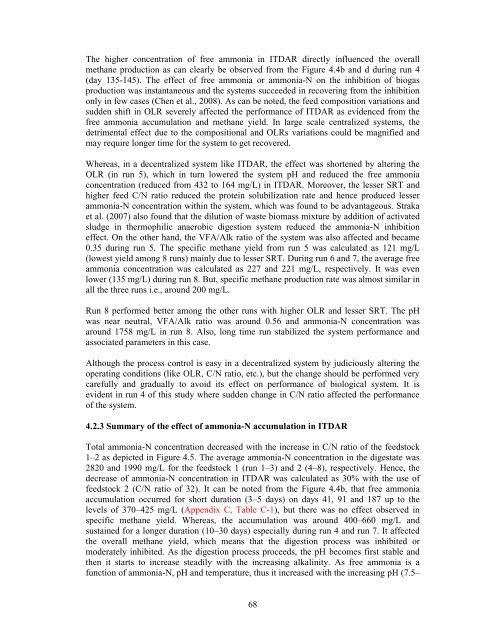dry anaerobic digestion of municipal solid waste and digestate ...
dry anaerobic digestion of municipal solid waste and digestate ...
dry anaerobic digestion of municipal solid waste and digestate ...
You also want an ePaper? Increase the reach of your titles
YUMPU automatically turns print PDFs into web optimized ePapers that Google loves.
The higher concentration <strong>of</strong> free ammonia in ITDAR directly influenced the overall<br />
methane production as can clearly be observed from the Figure 4.4b <strong>and</strong> d during run 4<br />
(day 135-145). The effect <strong>of</strong> free ammonia or ammonia-N on the inhibition <strong>of</strong> biogas<br />
production was instantaneous <strong>and</strong> the systems succeeded in recovering from the inhibition<br />
only in few cases (Chen et al., 2008). As can be noted, the feed composition variations <strong>and</strong><br />
sudden shift in OLR severely affected the performance <strong>of</strong> ITDAR as evidenced from the<br />
free ammonia accumulation <strong>and</strong> methane yield. In large scale centralized systems, the<br />
detrimental effect due to the compositional <strong>and</strong> OLRs variations could be magnified <strong>and</strong><br />
may require longer time for the system to get recovered.<br />
Whereas, in a decentralized system like ITDAR, the effect was shortened by altering the<br />
OLR (in run 5), which i n turn lowered the system pH <strong>and</strong> reduced the free ammonia<br />
concentration (reduced from 432 to 164 mg/L) in ITDAR. Moreover, the lesser SRT <strong>and</strong><br />
higher feed C/N ratio reduced the protein solubilization rate <strong>and</strong> hence produced lesser<br />
ammonia-N concentration within the system, which was found to be advantageous. Straka<br />
et al. (2007) also found that the dilution <strong>of</strong> <strong>waste</strong> biomass mixture by addition <strong>of</strong> activated<br />
sludge in thermophilic <strong>anaerobic</strong> <strong>digestion</strong> system reduced the ammonia-N inhibition<br />
effect. On the other h<strong>and</strong>, the VFA/Alk ratio <strong>of</strong> the system was also affected <strong>and</strong> became<br />
0.35 during run 5. The specific methane yield from run 5 was calculated as 121 mg/L<br />
(lowest yield among 8 runs) mainly due to lesser SRT. During run 6 <strong>and</strong> 7, the average free<br />
ammonia concentration was calculated as 227 <strong>and</strong> 221 mg/L, respectively. It was even<br />
lower (135 mg/L) during run 8. But, specific methane production rate was almost similar in<br />
all the three runs i.e., around 200 mg/L.<br />
Run 8 performed better among the other runs with higher OLR <strong>and</strong> lesser SRT. The pH<br />
was near neutral, VFA/Alk ratio was around 0.56 <strong>and</strong> ammonia-N concentration was<br />
around 1758 mg/L in run 8. Also, long time run stabilized the system performance <strong>and</strong><br />
associated parameters in this case.<br />
Although the process control is easy in a decentralized system by judiciously altering the<br />
operating conditions (like OLR, C/N ratio, etc.), but the change should be performed very<br />
carefully <strong>and</strong> gradually to avoid its effect on performance <strong>of</strong> biological system. It is<br />
evident in run 4 <strong>of</strong> this study where sudden change in C/N ratio affected the performance<br />
<strong>of</strong> the system.<br />
4.2.3 Summary <strong>of</strong> the effect <strong>of</strong> ammonia-N accumulation in ITDAR<br />
Total ammonia-N concentration decreased with the increase in C/N ratio <strong>of</strong> the feedstock<br />
1–2 as depicted in Figure 4.5. The average ammonia-N concentration in the <strong>digestate</strong> was<br />
2820 <strong>and</strong> 1990 mg/L for the feedstock 1 (run 1 –3) <strong>and</strong> 2 (4–8), respectively. Hence, the<br />
decrease <strong>of</strong> ammonia-N concentration in ITDAR was calculated as 30% with the use <strong>of</strong><br />
feedstock 2 (C/N ratio <strong>of</strong> 32). It can be noted from the Figure 4.4b, that free ammonia<br />
accumulation occurred for short duration (3 –5 days) on days 41, 91 <strong>and</strong> 187 up to the<br />
levels <strong>of</strong> 370–425 mg/L (Appendix C, Table C-1), but there was no effect observed in<br />
specific methane yield. Whereas, the accumulation was around 400–660 mg/L <strong>and</strong><br />
sustained for a longer duration (10–30 days) especially during run 4 <strong>and</strong> run 7. It affected<br />
the overall methane yield, which means that the <strong>digestion</strong> process was inhibited or<br />
moderately inhibited. As the <strong>digestion</strong> process proceeds, the pH becomes first stable <strong>and</strong><br />
then it starts to increase steadily with the increasing alkalinity. As free ammonia is a<br />
function <strong>of</strong> ammonia-N, pH <strong>and</strong> temperature, thus it increased with the increasing pH (7.5–<br />
68

















